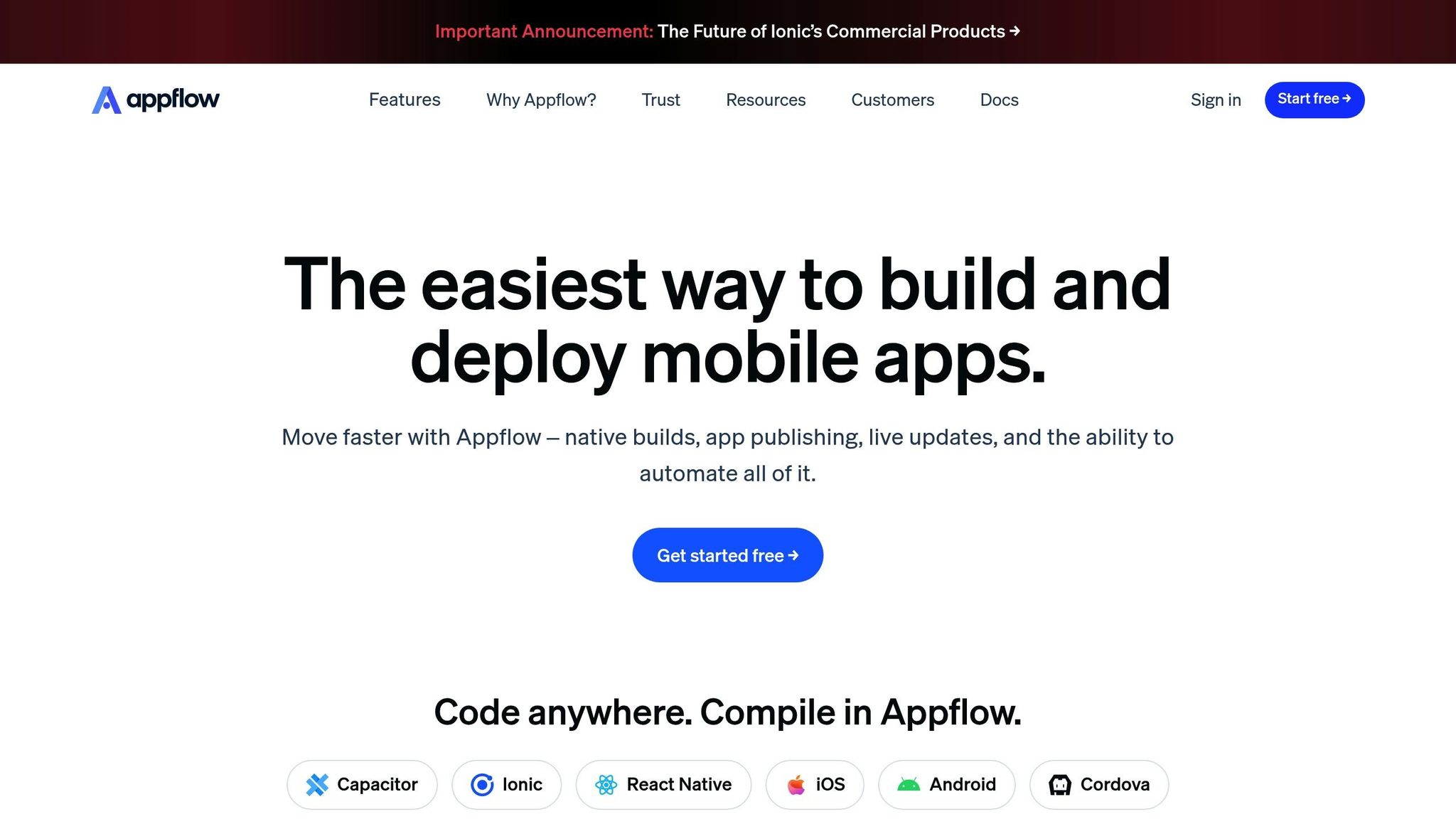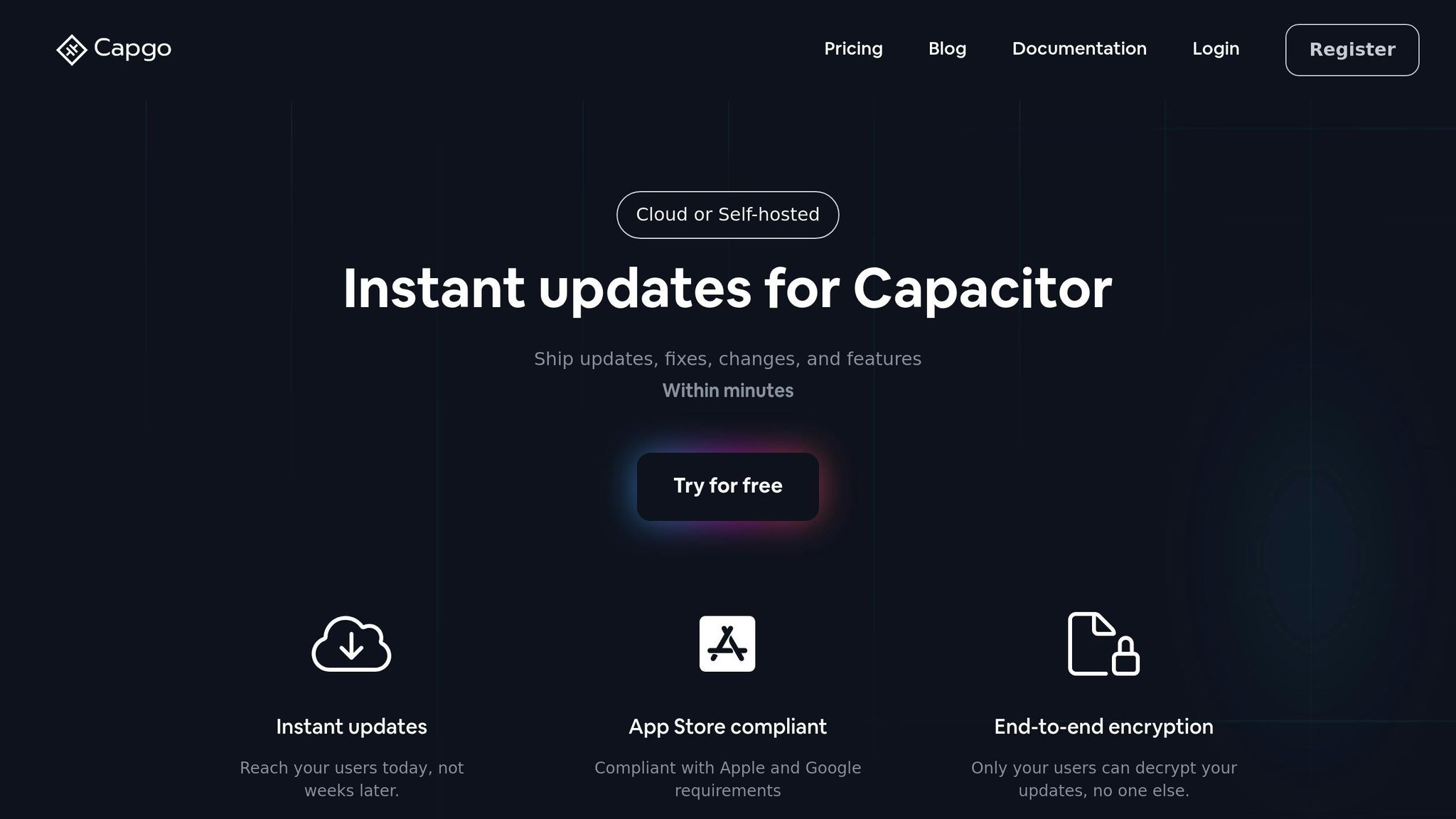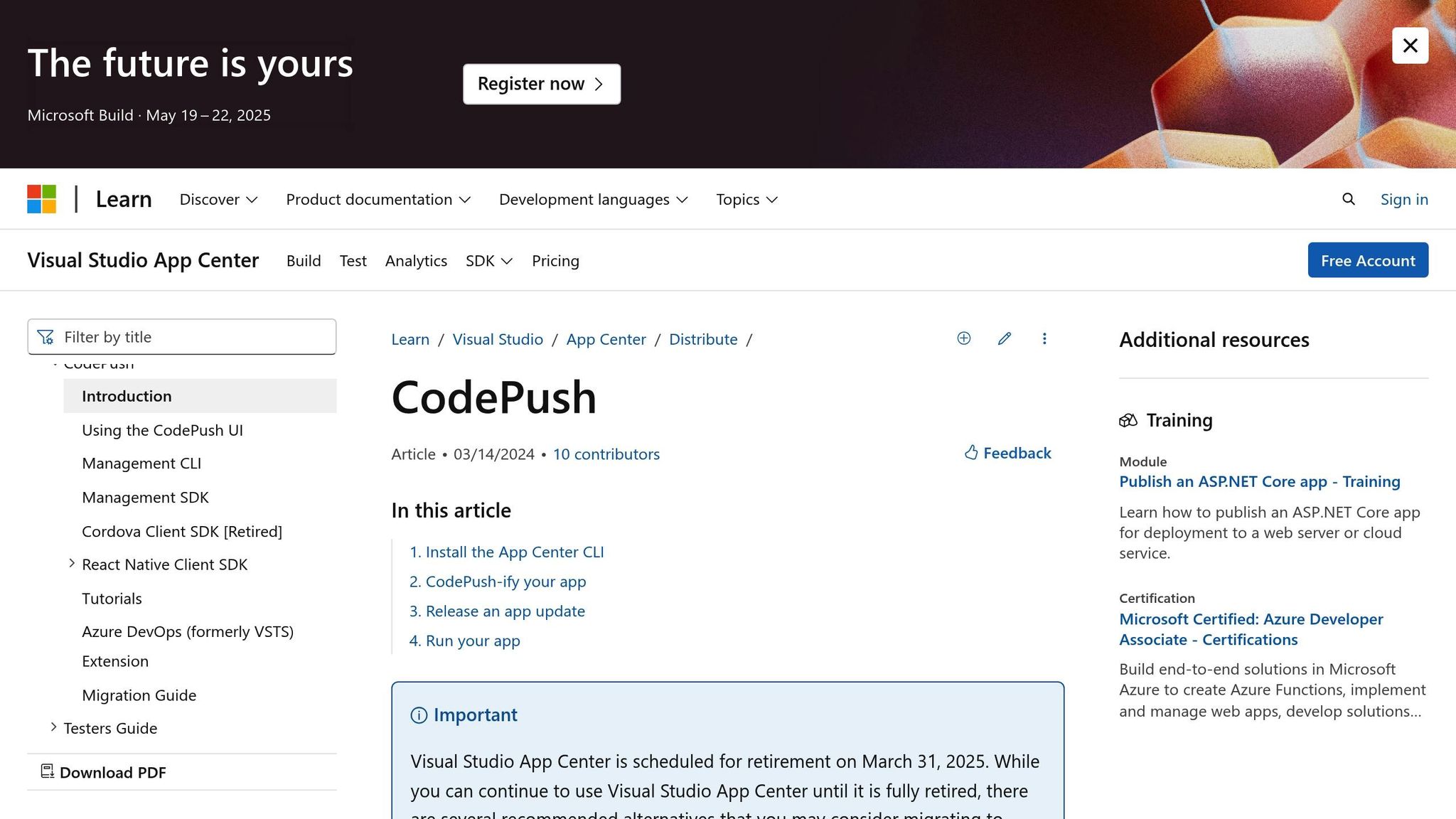Appflow CI/CD simplifies mobile app updates with over-the-air (OTA) updates, enabling 95% of users to receive updates within 24 hours. It offers automated tools for iOS and Android builds, app store deployments, and command-line management. However, rising costs (up to $6,000 annually) have led some teams to explore alternatives like Capgo, which offers faster updates and lower pricing.
Key Takeaways:
- Core Features: OTA updates, automated builds, app store deployment, CLI tools.
- Setup Tips: Use branch-based automation, secure environment variables, and role-based access control.
- Alternatives: Capgo provides similar features at a lower annual cost (~$3,600) with faster update speeds.
Quick Comparison:
| Feature | Appflow | Capgo |
|---|---|---|
| Annual Cost | $6,000 | ~$3,600 |
| Setup Fee | Included | $2,600 (one-time) |
| Update Speed | Reliable | 114 ms for 5 MB bundles |
| Trial Period | Limited | 15 days |
Choosing the right CI/CD solution depends on balancing cost, speed, and update reliability.
Integrate Appflow with your CICD Pipeline

Appflow CI/CD Core Features
Appflow CI/CD offers four key features designed to simplify mobile app development and deployment. These features help automate builds, deployments, and updates across mobile platforms.
Direct App Updates
With Appflow, teams can push updates directly to users’ devices without waiting for app store reviews. This over-the-air (OTA) update system allows developers to quickly address user feedback or release urgent fixes, keeping apps up-to-date and responsive to user needs.
iOS and Android Build Tools
Appflow automates the building process for both iOS and Android platforms. For iOS, it manages tasks like code signing, provisioning, and Xcode settings. For Android, it handles Gradle automation, keystore management, and generates APKs or app bundles. This ensures consistent builds for frameworks like React Native and Capacitor.
App Store Deployment
Submitting apps to app stores becomes easier with Appflow’s automated deployment pipelines. It takes care of tasks like binary preparation, versioning, metadata management, and compliance checks. This automation minimizes manual effort while ensuring smooth and consistent releases.
Command Line Tools
Appflow offers CLI tools that let developers manage builds and deployments directly from the command line. These tools support customizable build steps and environment configurations, making it easier to tailor CI/CD pipelines to specific project needs while maintaining consistency across teams.
Setting Up Appflow CI/CD
Learn how to configure Appflow CI/CD for smooth, automated builds and deployments.
Environment Setup Steps
Set up distinct environments aligned with your version control branches:
- Development: For daily builds and testing.
- Staging: A replica of production for final testing.
- Production: For live app releases.
Store environment variables securely using Appflow’s built-in encrypted storage.
Automating the Build Process
Here’s how to automate your build process effectively:
Branch-Based Automation
Set up automated build triggers for different git branches:
- Feature branches: Trigger development builds.
- Main branch: Kick off staging builds.
- Release branches: Initiate production builds.
Build Configuration
Customize your appflow.config.json to define:
- Build environments.
- Platform-specific settings.
- Dependencies and their versions.
- Output configurations.
To keep your pipeline secure, enforce strict access controls and encryption.
Security Settings
1. Token Management
Store authentication tokens securely using Appflow’s encrypted variables. Avoid exposing sensitive credentials in build logs or configuration files.
2. Access Control
Implement role-based access control (RBAC):
- Allow only senior developers to handle production deployments.
- Restrict staging access to the development team.
- Provide the QA team with read-only access.
3. Data Protection
Encrypt all sensitive data during transmission and storage, including:
- API keys
- Certificates
- Environment variables
- Build artifacts
Testing and Recovery Plans
To ensure app stability, establish thorough testing and recovery strategies:
Automated Testing
Integrate automated tests into your pipeline, such as:
- Unit tests
- Integration tests
- UI automation tests
Recovery Procedures
Prepare these key recovery mechanisms:
| Recovery Type | Implementation | Activation Trigger |
|---|---|---|
| Quick Rollback | Restore the previous version | Failed deployment |
| Version Control | Automate git revert | Build failure |
| Data Backup | Schedule automated snapshots | Configuration corruption |
OTA Update Platform Comparison
As Appflow continues to serve its users, new alternatives are stepping up with competitive features and pricing. OTA update platforms now offer various live update methods, catering to different needs. Here’s a breakdown of key options.
Capgo Features and Pricing

Capgo delivers updates impressively fast, clocking in at 114 ms for 5 MB bundles through its global CDN, with an API response time of 434 ms [1]. It powers 1.9K production apps and has delivered over 1,155 billion updates, showcasing its reliability [1].
| Feature | Capgo | Appflow |
|---|---|---|
| Annual Cost | ~$3,600 | $6,000 |
| CI/CD Setup | $2,600 (one-time) | Included |
| Monthly Operations | ~$300 | ~$500 |
| Trial Period | 15 days | Limited |
While Capgo offers competitive pricing and performance, other platforms cater to specific regions or rely on older methods.
Microsoft CodePush Legacy

Microsoft CodePush, which will shut down in 2024, has driven many users to seek platforms with better security and reliability. As one developer shared:
“Cancelled my @Appflow subscription after 4 years. Code-Push never seemed to work well, hopefully @CapGO has it figured out.” – LeVar Berry [1]
This shift underscores the demand for dependable update delivery and rollback capabilities. Even NASA’s OSIRIS-REx team chimed in:
“@Capgo is a smart way to make hot code pushes (and not for all the money in the world like with @AppFlow) :-)” [1]
These examples highlight the growing preference for solutions that combine cost savings with operational efficiency.
Mobile CI/CD Problem Solving
Platform Build Requirements
Building for iOS and Android requires careful setup of Appflow’s CI/CD pipeline. For iOS, you’ll need valid certificates and provisioning profiles configured in the build environment. Android builds rely on proper keystore management and signing setups. Both platforms also require diligent version management to prevent conflicts.
Here’s a quick overview of key configurations and common challenges:
| Platform | Required Configuration | Common Issues |
|---|---|---|
| iOS | Certificates & Provisioning | Expired certificates, profile mismatches |
| Android | Keystore & Signing | Mismanaged keys, version conflicts |
| Both | Environment Variables | Missing secrets, incorrect paths |
Apart from configuring builds, ensuring smooth update delivery is equally important.
OTA Update Speed and Reliability
A strong CI/CD pipeline depends on fast and reliable update delivery. While Appflow is popular, some teams have noted challenges with code-push performance, emphasizing the need for effective rollback and monitoring systems.
To improve update delivery and reduce interruptions, follow these practices:
- Use staged rollouts to minimize risks.
- Track update success rates to identify issues early.
- Set up automated rollback triggers for quick recovery.
When choosing CI/CD tools, prioritize metrics like update efficiency, deployment reliability, and rollback speed. Balancing fast deployments with consistent build quality is essential, especially for teams handling multiple platforms and frequent updates.
Conclusion: Appflow CI/CD Implementation
Development teams weighing CI/CD options often see Appflow as a mix of strengths and hurdles. Data indicates Appflow delivers updates fast - 95% of users receive updates within 24 hours, supported by strong CDN performance - and achieves an 82% global success rate[1].
However, rising costs are driving teams to explore cheaper alternatives. As highlighted by NASA’s OSIRIS-REx team:
“@Capgo is a smart way to make hot code pushes (and not for all the money in the world like with @AppFlow) 🙂” [1]
When implementing CI/CD, three key factors stand out:
| Factor | Implementation Focus | Impact |
|---|---|---|
| Speed | Instant deployment capability | Faster bug fixes and feature releases |
| Security | End-to-end encryption | Ensures secure update delivery |
| Compliance | App store requirement adherence | Maintains marketplace presence |
Prioritizing these areas helps teams adapt to the shifting CI/CD environment. With Appflow set to discontinue in 2026, it’s crucial to consider not just technical performance, but also cost efficiency, update reliability, and long-term platform stability.
As platforms handle 1,155.1 billion updates globally[1], efficient and reliable update delivery remains a critical focus for modern mobile app development. Balancing performance and cost is essential when choosing the right CI/CD solution.




